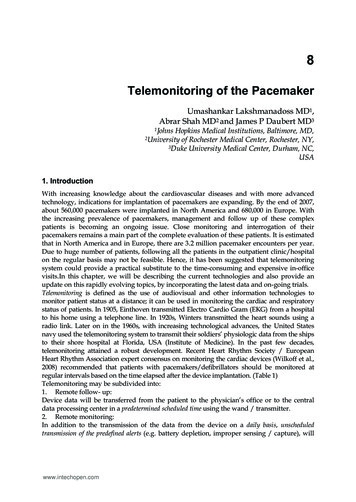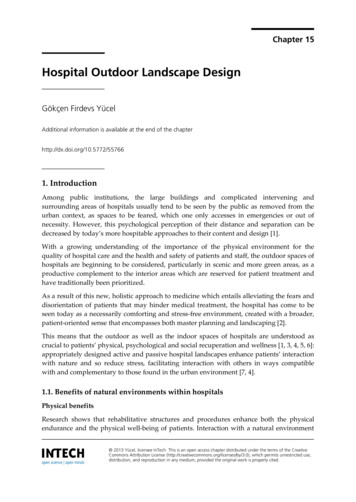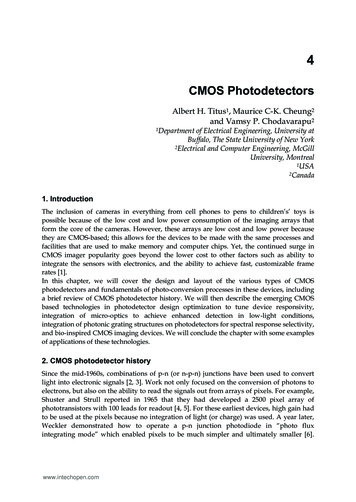
Transcription
8Telemonitoring of the PacemakerUmashankar Lakshmanadoss MD1,Abrar Shah MD2 and James P Daubert MD31JohnsHopkins Medical Institutions, Baltimore, MD,of Rochester Medical Center, Rochester, NY,3Duke University Medical Center, Durham, NC,USA2University1. IntroductionWith increasing knowledge about the cardiovascular diseases and with more advancedtechnology, indications for implantation of pacemakers are expanding. By the end of 2007,about 560,000 pacemakers were implanted in North America and 680,000 in Europe. Withthe increasing prevalence of pacemakers, management and follow up of these complexpatients is becoming an ongoing issue. Close monitoring and interrogation of theirpacemakers remains a main part of the complete evaluation of these patients. It is estimatedthat in North America and in Europe, there are 3.2 million pacemaker encounters per year.Due to huge number of patients, following all the patients in the outpatient clinic/hospitalon the regular basis may not be feasible. Hence, it has been suggested that telemonitoringsystem could provide a practical substitute to the time-consuming and expensive in-officevisits.In this chapter, we will be describing the current technologies and also provide anupdate on this rapidly evolving topics, by incorporating the latest data and on-going trials.Telemonitoring is defined as the use of audiovisual and other information technologies tomonitor patient status at a distance; it can be used in monitoring the cardiac and respiratorystatus of patients. In 1905, Einthoven transmitted Electro Cardio Gram (EKG) from a hospitalto his home using a telephone line. In 1920s, Winters transmitted the heart sounds using aradio link. Later on in the 1960s, with increasing technological advances, the United Statesnavy used the telemonitoring system to transmit their soldiers’ physiologic data from the shipsto their shore hospital at Florida, USA (Institute of Medicine). In the past few decades,telemonitoring attained a robust development. Recent Heart Rhythm Society / EuropeanHeart Rhythm Association expert consensus on monitoring the cardiac devices (Wilkoff et al.,2008) recommended that patients with pacemakers/defibrillators should be monitored atregular intervals based on the time elapsed after the device implantation. (Table 1)Telemonitoring may be subdivided into:1. Remote follow- up:Device data will be transferred from the patient to the physician’s office or to the centraldata processing center in a predetermined scheduled time using the wand / transmitter.2. Remote monitoring:In addition to the transmission of the data from the device on a daily basis, unscheduledtransmission of the predefined alerts (e.g. battery depletion, improper sensing / capture), willwww.intechopen.com
130Modern Pacemakers - Present and Futurealso happen. The data from the device will be transmitted and the physician will be notified,according to the predefined settings by the physician (e.g. information given to thephysician/health care provider through SMS, emails, contacting the office through phone).Minimum frequency of monitoring of pacemakers either in person or remotelyWithin 3 days ofImplantation2-12 weeks postimplantationEvery 3-12 months afterimplantationEvery 1-3 months at signs ofbattery depletionAnnually until depletion ofbatteryRemote monitor-In person follow - upX-XXXXX-XTable 1. Timeline for follow up of the PacemakersX – Recommended; - Not recommended3. Bidirectional telemetry:In addition to the remote monitoring of the pacemakers, remote interrogation and remoteprogramming of the pacemakers can be done with newer revolutionary technologies.2. Importance of monitoring the pacemaker:Monitoring of pacemakers is necessary for both patient- and device-related factors. Wilkoffet al. (2008) described the various important reasons and goals of monitoring pacemakers.By closely monitoring the pacemakers, the clinician would achieve the goals outlined below.(Table 2)Patient Centered FactorsOptimize the patient’s quality of lifeIdentify the patients at risk (based on the alerts) and appropriate follow upIdentify any abnormal brady / tachy arrhythmiasIdentify non device related problems and appropriate referralsPatient safetyPeace of mind for the patientDevice Related FactorsOptimize the pacemaker function to meet patients’ needIdentify and correct abnormal device functionIdentify the end of life of the battery, monitor lead dysfunctionMonitor the various alerts by the device and triage accordinglyMaintain a database for future research purpose.Table 2. Factors effecting pacemaker placementwww.intechopen.com
Telemonitoring of the Pacemaker1313. Description of the telemonitoring technology:Implanted pacemakers are pre-equipped with a micro-antenna, which communicates with asmall external device, commonly known as transmitter. A receiver or “wand,” is attached bya wire to the programmer and positioned on the body’s surface over the pacemakerimplantation site to receive the telemetry signal from the pacemaker. The wand will betalking to the device as radiofrequency signals {either the Industrial, Scientific and Medical(ISM) band from 902–928 MHz or a subsection of the Medical Implant and Communications(MICS) band from 402–405 MHz}. The distance for radiofrequency signal communicationhas increased from several cm to several meters and some devices can even communicatewithout a wand. The transmitters are able to interrogate programmed parameters anddiagnostic data stored in the device memory with active participation of patient (via awand), or automatically (wandless), at preset time intervals. The data downloaded from thedevice by the transmitter is then uploaded as an encrypted data, to a secured clinicaldatabase either by a standard analog phone line or through wireless GSM (Global Systemfor Mobile) connection. The programmer is a computer with specific software andassociated hardware modifications that provide highly reliable exchange of the encryptedinformation and precise communication with the cardiac device. The transmission of thesedata may be initiated by patient (as a scheduled transmission or event triggered (symptom /alert by device).Fig. 1. Telemonitoring technology.The data will be processed in central processing center, which is usually maintained by thedevice manufacturers. The data will be uploaded in a secure website and a health careprovider can login and look into the events (Figure 1). In addition to the uploading of thedata to website, depending on clinical urgency, the concerned health care provider will benotified via email, SMS, fax or telephone call as predefined by the physicians. Moreover,some manufacturers follows a traffic light like system, in which the alerts will be sent to theclinician in varying colors like red, yellow and green, depending on the magnitude of theproblem. Otherwise, after initiating manual transmission, patient also can call the physician,who can login to the password protected secure website and look into the events.Typically, the following informations are transmitted to database: heart rate, battery status,lead integrity, pacing lead impedance, episodes of arrhythmias, delivered antitachycardiapacing, percent pacing, histogram, real-time and magnet Electrograms (EGM), stored EGMswww.intechopen.com
132Modern Pacemakers - Present and Futureand arrhythmia summary with mode switch duration. These data will help the clinician todiagnose any active problems. In addition, monitoring of the silent events likeasymptomatic atrial fibrillation is very important as these arrhythmias are proven to be anindependent risk factor for increased mortality in patients with heart failure. In addition tothese data, patient can also enter his blood pressure measurements, body weights and othersymptoms related to heart failure (in patients with Cardiac Resynchronization Therapy{CRT}). Based on these data, physicians would be able to make changes in the managementof the patient’s condition.Programmers can also communicate the interrogated data to a remote printer for a hard copypresentation or be transferred to a database or Electronic Medical Record (EMR). To connect tothe database or to EMR, the data are saved and then transferred via disc, CD ROM, USB drive,directly by a network cable, Bluetooth or Wi-Fi communication to an internet or intranetnetwork connection. The ISM and MICS radiofrequency communication is used only forconnecting the pacemaker to the programmer or remote telemetry device and not forconnecting the programmer to printers, saved files, the database, EMR or registries.4. Types of remote transmission:4.1 Patient initiated remote transmission:In this mode of transmission, the initiation of data transfer from the pacemaker is done bythe patient himself / herself. This may be a regular, scheduled transmission or anunscheduled transmission, triggered either by the patient symptoms (like shortness ofbreath, lightheadedness, syncope, palpitations) or in response to an alert given by thepacemaker (usually an audible sound or vibration).4.2 Device initiated remote transmission:In this mode of transmission, initiation of data transfer from the pacemaker is done by thepacemaker itself. Data will be transferred on a regular scheduled basis, at fixed timeintervals (often at night, when the patient is lying in bed). Usually, the patient need notplace the wand over the pacemaker. The pacemaker itself will “talk” to the home monitor/communicator and initiate transfer. If there is any change in patient’s physiologic data orany new alerts by the pacemakers, there will be an unscheduled initiation of the datatransfer from the pacemaker, even without the knowledge of patient.4.3 Transtelephonic monitoring without interrogation:This is one of the older techniques. This technology is solely limited to pacemaker followup. In this method of transmission, patient must initiate data transmission through atelephone. Each transmission usually includes an initial rhythm strip and then a rhythmstrip demonstrating magnet rate of pacing system. Telephone transmissions provide only abrief snapshot of cardiac rhythm and thus intermittent problems may not be detected. It stillhas some value in monitoring the pacemakers approaching end of life and in need ofelective replacement of the battery.5. Types of various tele monitors by 4 major companies:The following four types of remote monitors are produced by the various pacemakermanufacturers:www.intechopen.com
Telemonitoring of the Pacemaker1335.1 BiotronikIn 2001, Biotronik introduced wireless remote monitoring of cardiac devices. BiotronikHome Monitoring uses three simple colours to quickly and automatically convey a wealth ofvital information to physicians who need on-the-spot patient data anywhere, any time.When activated, Home Monitoring (Biotronik & Co. KG, Berlin, Germany) transmits datasystematically on a daily basis, at a fixed time of day (usually in the night times), via aspecial cell phone-like instrument (CardioMessenger , Biotronik Figure 2)) kept within 2 mfrom the implanted device. The transmission utilizes state-of-the-art encrypted SMStechnology to transfer worldwide data to a dedicated center.Fig. 2. CardioMessenger from BiotronikEvent notifications are assigned by the physician with a red or yellow colour-code to ensurethat only serious or important patient status changes are alerted to the physician. The"red-dot" principle serves as a simple navigator that lets physicians quickly assess thepatient's status at a glance while allowing them to focus only on those cases with clinicallyrelevant events. In addition to color-coded messages on the internet, the physician receives anotification via email, fax, or text message in case of serious changes in the patient’s status.indicates a severe deviation from a defined threshold with high priority.RedYellowindicates an important deviation from a defined threshold with priority.Whiteindicates the absence of any severe or important change.When a clinically relevant status change occurs, Biotronik Home Monitoring generates anevent alert via email, SMS, or fax to the physician while simultaneously displaying theseverity of the patients' status on the secure Biotronik Home Monitoring website. It alsooffers information that might allow the detection of adverse events on average of 2 and 5www.intechopen.com
134Modern Pacemakers - Present and Futuremonths earlier than feasible by standard care in patients followed quarterly and biannually,respectively (Ellery et al., 2006). The majority of the alerts are disease-related, prompted byatrial fibrillation, ventricular arrhythmias, and ICD or CRT therapy, in particular.5.2 CareLink CareLink is produced by Medtronic, Minneapolis, MN, USA. The monitor produced byCareLink is very small, about a pound in weight and easy to carry in a brief case. On thescheduled day, patients have to simply connect their monitor to a regular phone line, pushthe start button, and hold the antenna over heart device. The monitor sends the deviceinformation and turns itself off when the transmission is done. Data will be transferred tothe secure central data collecting system; from there, the information will be passed on tothe health care personnel as guided by the urgency of the information.If patients have a Medtronic heart device with Conexus Automatic Monitoring, the devicedata may be sent automatically, usually while the patient is sleeping. These transmissionsare scheduled by the clinical team. On the scheduled night, the device “wakes up” andcommunicates with the monitor. The monitor silently sends the device data, withoutassistance from the patient.Heart devices with automatic monitoring are able to send a CareAlert notification to thedatabase, when certain conditions are met, such as low battery or an irregular heartbeat.This information will be appropriately transmitted to medical team (Figure 3).Fig. 3. CareAlert www.intechopen.com
Telemonitoring of the Pacemaker1355.3 LatitudeFig. 4. Latitude Home Monitoring SystemLatitude system uses a wireless (e.g. radio frequency or Bluetooth ) feature that offers dailyand/or weekly status checks with physician notification. This feature can be activated forpatients who have a device that uses ZIP Wandless Telemetry, and/or for patients who usethe weight scale from the Latitude Heart Failure Management system.There are two levels of alert conditions: red alerts and yellow alerts. The alerts are designedto provide the physician advance notification of a potential health or device problem.Conditions that could potentially leave the patient without available device therapy result indeclaration of a red alert (Table 3). Notification of red alerts is not configurable, as thedevice-following physician will always be notified if a red alert is detected on the Latitudesecure server. By default, notification is sent by telephone, but there are several notificationoptions for red alerts as described in “Red Alert Notification Preferences.”www.intechopen.com
136Modern Pacemakers - Present and FutureDaily Measurement Red Alerts High or low shock lead impedance High or low right ventricular pacing lead impedanceRed Alerts Indicating Potential Loss of Therapy Device battery has reached end of life (EOL) Remote monitoring disabled due to limited battery capacity High or low shock lead impedance detected when attempting to deliver a shock High voltage detected on shock lead during charge Ventricular tachycardia mode change due to magnet Ventricular tachycardia mode set to value other than monitor therapy Possible malfunction Device parameter errorTable 3. Red alert notifications occur for the above conditions, depending on device modelDevice battery has reached Elective Replacement Indicator (ERI)Explant indicator reachedVoltage was too low for projected remaining capacityVentricular pacing leads Low right ventricular intrinsic amplitude High right ventricular intrinsic amplitude Low left ventricular intrinsic amplitude High left ventricular intrinsic amplitude Low left ventricular pacing lead impedance High left ventricular pacing lead impedanceAtrial pacing leads Low atrial intrinsic amplitude High atrial intrinsic amplitude Low atrial pacing lead impedance High atrial pacing lead impedanceArrhythmias Shock therapy delivered to convert arrhythmia (ventricular) Accelerated arrhythmia episode (ventricular) Atrial arrhythmia burden within a 24-hour periodPatient triggered event storedPacing Cardiac resynchronization therapy pacing percentage Right ventricular pacing percentageAn average daily weight change of 2 pounds or more over multiple daysChange of 5 pounds or more any time within a weekTable 4. Yellow alert notifications occur for the above conditions, depending on devicemodel and on the physicians’ preferencewww.intechopen.com
Telemonitoring of the Pacemaker137Notification of yellow alerts is optional by the physicians. Notification for yellow alerts isprovided through the Latitude website and, optionally by other methods such as fax. Aphysician may choose to receive some, all, or none of the yellow alerts. Yellow alertnotifications can be configured for the above conditions, depending on device model (Table 4).5.4 Merlin@Home :Fig. 5. Merlin@ home Transmitter In 2008, St Jude got FDA approval for Merlin@ home transmitter (Figure 5), a radiofrequency wireless technology that remotely monitors patients' implanted cardiac devices.The Merlin@ home transmitter's wireless technology gives patients the additional comfortof having devices automatically checked. Since the transmitter initiates scheduled follow-upand uses radio frequency wireless telemetry to download data from device, entire follow-upprocedure is conducted without any direct patient involvement. The only requirement isthat each patient remains within range of the transmitter while it reads his or her device.Patients also may initiate data transmissions as instructed by their physicians. Datadownloaded by the Merlin@home transmitter is sent to Merlin.net, a secure, internetbased data management system, where it is stored for review by the patient's physician. Thedata can also be linked in to the Electronic Health Record / Electronic Medical Recorddirectly and can be stored there for future references.Table comparing the 4 types of available remote monitors:Major differences among the available systems include degree of patient involvement indata transmission, transmission modality, transmission scheduling, and patient alerts asdetailed in Table 5.www.intechopen.com
138Modern Pacemakers - Present and FutureBiotronikSystem ved inAmerica andEuropeDevice toProgrammerWirelessProgrammerto ServerPatientinvolvementPatient devicecharacteristicsFrequency oftransmissionsRemotefollow upRemoteMonitorMedtronicBostonScientificSt JudeCareLinkTMLatitudeTMMerlin.netTMAutomatic /ManualAmerica andEuropeWand /WirelessAutomatic/ManualAmerica andEuropeWand /WirelessAutomatic /ManualAmerica andEuropeWand /Wireless4 – band GSMnetwork (Cellularnetwork)Analoguephone lineAnaloguephone lineAnaloguephone ryDaily FU; AlerteventsScheduled FU;Alert eventsScheduled FU;Alert eventsScheduled FU;Alert eventsYesYesYesYesYesYesYesYesWebsite longtermStandard as inProgrammerWebsite longtermStandard as inProgrammerData storageWebsite long termDatapresentationReal - time/stored EGM(duration)TransmissiontimeFeedback tothe patientviatransmitterProcessed asgraphs and tablesWebsite longtermStandard as inProgrammer45 seconds10 seconds10 seconds30 seconds 0.5 minute 3 minutes5 minutes 3 minutesLED indicating thestatusLED indicatingthe statusAutomatic textand audiomessagesLED indicatingthe statusWireless PMsConfigurablered and yellowalertsConfigurablered and yellowalertsAutomatedphone calls topatientsSpecialFeaturesTable 5. Comparison of the four different
When activated, Home Monitoring (Biotronik & Co. KG, Berlin, Germany) transmits data systematically on a daily basis, at a fixed time of day (usually in the night times), via a special cell phone-like instrument (CardioMessenger , Biotronik











